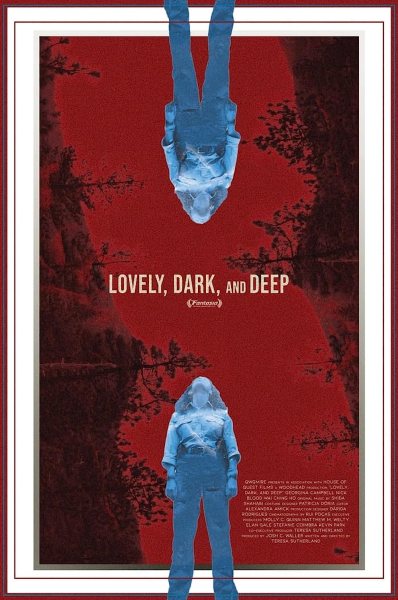


The unknowability of nature, and the vast unsympathetic spaces found within it, have a certain raw and primal horror to them. The howling gulf of a valley, the distant spire of a mountain, the sinister and beckoning dark of a forest: all of these and more claw at our ancestral hindbrain in a way that triggers some kind of animalistic instinct to retreat. For some, the call of the wild is a call to freedom. For others, however, it is an invitation to something terrible. And Teresa Sutherland captures that vague, ominous feeling perfectly with Lovely, Dark, And Deep.

Lovely, Dark, and Deep is the story of Lennon, a park ranger on her first outing in the fictional Avores National Park. What starts out as a typical ranger exercise turns into an excursion in the uncanny after Lennon helps locate a missing hiker found bloodied and hysterical who greets Lennon with a chilling question: “Are you real?” Soon, Lennon finds herself not just awash in high strangeness and psychedelic terror but also in the midst of a weird Lovecraftian tale of bargaining with powers we cannot comprehend, a sort of Adam Neville short story told through a Kubrickian lens.
This film could very easily have fallen into the many hackneyed cliches that work on the largely debunked (but still creepy as all heck) Missing 411 phenomenon, or just fallen back on the standby of ‘it’s Bigfoot/aliens taking these people!’. Instead, Sutherland deftly crafts an atmosphere of dread, dropping hints here and there, using long shots of Lennon alone in the wilderness highlighted by subtle but ominous musical scoring, with just enough creepy imagery to keep us on our toes. Rather than shoving the answer in our faces or presenting us with a disjointed mishmash of weirdness, Sutherland does just enough to grab our attention and then stands back, hands us a fork and a knife, and says, ‘alright now have at it’. The phenomenon is never explicated explained, or even implicitly hinted at. Rather, Sutherland affirms that yes, something external is at work here. This isn’t just in her head. People are actually missing. But ultimately, whether its aliens or grumpy sasquatch is unimportant to the story. It’s not so much about the phenomenon as it is how your everyday citizen would deal with facing such phenomenon. The story is Ranger Lennon’s, not whatever is out there taking people in national parks.

Sutherland’s camerawork goes a long way in showing how alone Ranger Lennon (and by extension the viewer) actually are. There’s a ton of drone shots coming in from high above showing us miles and miles of unbroken wilderness and then coming down to show Lennon and how utterly insignificant she is. There are shots with vast stretches of negative space to again illustrate the void that surrounds her. And, more importantly to upping the creepy factor, there’s a reoccurring use of the camera looking up at the trees from the bottom to not only show just how massive the trees are, but to show how they move in the wind. This imbues the land itself with an ominous feel, a sort of malicious intent, as if it’s a silent antagonist that’s out to ensure Ranger Lennon meets a less than pleasant fate.
Georgina Campbell as Ranger Lennon shoulders much of the narrative, as she is not just the main character but also one of maybe five characters throughout the entire film. She makes Lennon a quietly dedicated character, someone who experienced pain in the past and is determined to get to the root of that pain through her work as a ranger. She brings to life someone who, while largely inexperienced, is still super competent and eager to fulfill her duties by helping people. Even at the end, when she becomes privy to the truth of what has been going on in the park for decades, there’s still part of her seems ashamed of her own cowardice and wants to plunge forward and do the right thing. As for her troubled past, as the film progresses it’s clear that maybe Lennon shouldn’t be trying to find any answers to what happened to her younger sister but perhaps should just try and process that loss in a healthy way, but either way this, ah, misstep on Lennon’s part leads to some interesting places and raises some rather meaningful questions on the nature of grief and recovery.
Lovely, Dark, And Deep is a film that I’m sure some people will hate because ‘they don’t show anything!’, but it doesn’t matter. This is an awesome exercise in doing a lot with a little and telling a simple but powerful story about loss and grief. And it’s creepy. Watching this movie took me back to the time I was at the Mojave Lava Tube in California, and as I stood at the top of the stairs, I realized I was the only person literally for miles. I could see out into the vast stretches of nothingness, and my car was but a speck in that nothingness. I was completely and utterly alone. And yet…I didn’t feel alone. I felt like there was something watching me. It was a fear bubbling up from the part of my brain that kept my ancestors safe from those giant bears that used to feast on early humans up in the arctic. I just knew there was something unsettling about all that emptiness, and Lovely, Dark, And Deep brought all those feelings back to the surface. It is, literally, a film about staring into the void and hoping that there isn’t anything staring back.
Click here for an interview with director Teresa Sutherland




